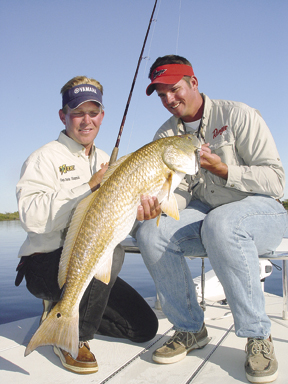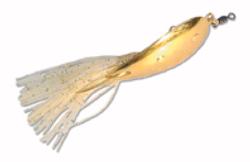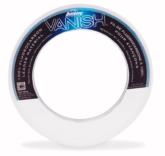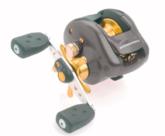Working grass mats
A floating oasis that provides an ideal ambush point for aggressive redfish

Fishing in water barely knee-deep is not uncommon along the Gulf of Mexico outside of Venice, La. So as three anglers stood casting Heddon Zara Spooks along the edges of matted grass, no one was all that surprised at the missile that propelled itself out of the water, swallowed the bait and then took off like it was on fire.
“Is this exciting or what?” yelled Billy Murray, a Texas resident and frequent redfish angler.
When a redfish is on the end of an angler’s line, one thing immediately becomes clear: The fish is in no rush to get to the boat. The drag on the reel squeals something awful, the rod buckles and bows violently, as if genuflecting to the mighty, surging creature. And after several minutes of give-and-take – more like take in the case of redfish – a reddish-colored brute, with broad shoulders and a torpedo-shaped body, makes its way to the boat, flapping and sloshing all the way.
Whew! What a rush! The travails of catching redfish are part fun and part fight, but entirely excitement. If ever there was a fish whose reputation was more substance than hype, this is it.
Redfish, which are found all along the Gulf of Mexico and up the Atlantic seaboard, can be caught in a myriad of ways with a vast assortment of baits. For example, anglers use everything from soft-plastic shad bodies on a leadhead to corks impaled on a hook.
 In the spring, however, when the large mats of grass show up all along shallow lagoons, anglers break out everything from top-waters and casting spoons to soft plastics for some of the best fishing of the year.
In the spring, however, when the large mats of grass show up all along shallow lagoons, anglers break out everything from top-waters and casting spoons to soft plastics for some of the best fishing of the year.
When the first hint of spring arrives along the gulf, grass such as hydrilla, milfoil, turtle grass and numerous others begin to green up. This grass, which thickens to form mats that can be nearly impenetrable, provides cover for forage such as mullet, fiddler crabs and crawfish.
It also provides an ideal ambush locale for large, aggressive redfish.
“It’s just an area that holds a lot of food for fish,” said Ross Barkhurst, a Louisiana guide who anxiously anticipates fishing the Western Division of the Wal-Mart FLW Redfish Series, which kicks off in Port Aransas, Texas, May 13.
In the numerous shallow ponds in and around Venice, La., which is home to some of the best redfish action in the country, the grass can get so thick that it is nearly impossible to fish, he said. However, after a visit from one of the regions plentiful spring and summer rainstorms, these mats break up, with many floating out of the lagoons and entering the gulf. And as the grass in the lagoons disperses, Barkhurst sees an ideal angling opportunity.
He knows the reds are likely still in the area, and he knows just how to catch them. Armed with spinnerbaits, buzzbaits, casting spoons and a few select soft plastics, he goes to work on the grass mats with the skill of a surgeon.
First, he throws 1/2-ounce spinnerbaits along the openings all around the individual mats. If that lure should fail to draw a strike, he picks up a buzzbait, casting it along the edges and over the tops of the grass.
“They just explode on that buzzbait,” he said excitedly. “It’s a blast.”
Another trick he and other Louisianans employ is casting soft-plastic crawfish-imitating baits right onto the mats, then working them over the cover in much the same fashion as would a bass fisherman fishing a plastic frog. Barkhurst rigs a green pumpkin/Texas red craw on a 3/0 hook. He likes to crawl it over the grass and allow the lure to fall into holes in the mats.
Working these shallow ponds, where the water may be only a few feet deep, is not very difficult at all. But the results, well, they can be quite exciting.
“We catch a lot of tournament-quality fish (26 to 28 inches),” he said. “They just get in these ponds and bulk up.”
As the summer stretches on, the grass mats thicken even more. Now up to several inches thick in most places, both predator and prey are prone to bury themselves underneath the cover as a shield from the harsh sun. This is the time when anglers such as Gary Thompson of Baton Rouge, La., pull out casting spoons and go to work.
Casting spoons have for years been part of the arsenal of baits anglers employ for catching reds, especially when the fish are in shallow water. These lures, when reeled and pumped over shallow oyster beds, can yield dynamite action. But Thompson, a lure designer, fishes the metal spoon more like a plastic bait on the grass.
He casts it right onto the top of the grass, then slowly works it back to the boat. Sure, he allows it to fall into any holes that might be present. But even without holes, the reds do not seem to have a problem getting to the lure.
“They’ll come right up through the grass and nail it,” Thompson said. Another bait he uses when the fish are buried in the cover is one of his company’s weedless inline spinners, which features a grub body.
There really is no bad way to fish for reds when they inhabit the grass-laden shallow ponds, lagoons and flats. Typically, grass means forage is nearby, and that draws the reds.
However, shallow lagoons are not the only places to find reds in grass mats. As the mats disperse, washing out through canals and into and along open-water areas, it is not uncommon to see an acre of broken-up grass washed up against a sandbar or shoal.
In Texas, for instance, along the Laguna Madre Intracoastal Waterway, large sections of manatee or turtle grass can be seen floating along the expansive shallow flats so prevalent along the Gulf of Mexico. And in late summer, with fall quickly approaching, anglers can catch large numbers of reds by fishing this often-mobile grass.
Commonly, reds will move along the flats in the area using the grass as cover. Bruce Shuler, a guide out of Port Mansfield, Texas, has clients fish all around the edges of the grass, which might not be very thick but may litter an area over half an acre in size. Often the only giveaway that reds are in the area is skittering mullet – or a reel drag all of a sudden screaming for mercy.
Ideal lures in this scenario are top-water plugs or shallow-running crankbaits, all of which are great at getting the fish to work on the top. But Shuler will also have clients work the center of the grass and along the edges with soft-plastic shad baits in glow/ chartreuse colors, which are fished on a leadhead.
With several clients working a mat in this manner, it is usually not long before Shuler is heard making his frequent refrain: “Fish on!”
Watch the skies
When redfish are shallow around the edge of grass mats, chasing crabs and other forage, anglers can often look to the skies to find the fish’s locations. Seagulls, prevalent throughout coastal regions, often hover above schools of reds, awaiting any morsel of food the fish might miss.
So before heading out for the day, canvass the sky for any signs of activity.
If some birds are indeed seen working the water, cut the big engine at least 75 yards away from the activity and then move in with the trolling motor. Using top-water prop baits and buzzbaits, make long casts to where the fish are believed to be positioned.

Hold on
Catching redfish in shallow water around grass might seem like an easy task, especially given that they can only run a few feet deep when hooked. Wrong!
While they cannot go down, a big red can pull 50 or 60 yards of line off at a time, running at will across a grassy flat. And even after several minutes of this tug of war, an angler’s nerves and his line can become frayed.
 That is why it is important to use strong, abrasive-resistant line such as Berkley Vanish Transition. Many anglers use lines as light as 10 or 12 pounds, but for chasing bigger fish, go with 17- to 20-pound-test.
That is why it is important to use strong, abrasive-resistant line such as Berkley Vanish Transition. Many anglers use lines as light as 10 or 12 pounds, but for chasing bigger fish, go with 17- to 20-pound-test.
Sturdy rods are also a necessity for large reds. Just about any high-quality, 7-foot, medium- to heavy-action rod will do the job. But many anglers prefer 7-footers that have powerful butt sections, bend uniformly throughout and have fast tips to absorb surges from the fish.
 Another must is having a reel with a strong yet smooth drag. When pulling in big redfish, a drag that catches suddenly usually means the fish is going to say bye-bye.
Another must is having a reel with a strong yet smooth drag. When pulling in big redfish, a drag that catches suddenly usually means the fish is going to say bye-bye.